




American Journal of Innovative Research & Applied Sciences



| ISSN: 2429-5396 (e) | www.american-jiras.com | |
| Web Site Form: v 0.1.05 | JF 22 Cours, Wellington le Clairval, Lillebonne | France |
| Web Site Form: v 0.1.05 | JF 22 Cours, Wellington le Clairval, Lillebonne | France |


ResearchBib, Google Scholar, SIS database, i.f.s.i.j, Scribd, IISJ, Eurasian Scientific Journal Index (ESJI), Indianscience.in, arastirmax, Directory of Research Journals Indexing, Pak Academic Sesearch, AcademicKeays, CiteSeerX, UDL Library, CAS Abstracts, J-Gate, WorldCat, Scirus, IET Inspec Direct, and getCited
Indexed by:
| HOME || ABOUT US || ARCHIVES || AIMS AND SCOP || AUTHORS || REVIEW|| SUBMIT MANUSCRIPT || EDITORIAL BOARD || CONTACT US |
| HOME | ABOUT US | ARCHIVE | AIMS AND SCOP | AUTHORS | REVIEW | SUMIBMIT MANUSCRIPT | EDITORIAL BOARED | PUBLICATION FEE |
| | ARTICLES | Am. J. innov. res. appl. sci. Volume 7, Issue 1, Pages 54-64 (July 2018) |
| Research Article |
American Journal of innovative
Research & Applied Sciences
Research & Applied Sciences
ISSN 2429-5396 (Online)
OCLC Number: 920041286
OCLC Number: 920041286

| JULY VOLUME 7 | N° 1 | 2018 |
Authors Contact
*Correspondant author and authors Copyright © 2018:
| Mviri Hubert César 1 │ Entsiro François 1 │ Tira Juslain Joel 1 │ Litoto Pambou Lucien 2 │ Tsiama Portejoie Jean Aimé 1 │ Koulombo Armel Ulrich 1 │ Moulongo Jean Georges André *3 │ Massamba Alphonse 3 │ | and | Mbemba François 4 |.
*Correspondant author and authors Copyright © 2018:
| Mviri Hubert César 1 │ Entsiro François 1 │ Tira Juslain Joel 1 │ Litoto Pambou Lucien 2 │ Tsiama Portejoie Jean Aimé 1 │ Koulombo Armel Ulrich 1 │ Moulongo Jean Georges André *3 │ Massamba Alphonse 3 │ | and | Mbemba François 4 |.
Affiliation.
1. Université Hassan II de Casablanca | Faculté des Sciences Ben M’Sik | Département de Biologie | Laboratoire de Physiopathologie et
Génétique Moléculaire | Equipe de Métabolisme Nutrition Toxicologie | Casablanca | Maroc |
2.Ecole Nationale des Statistiques et d’Economie Appliquée (INSEA) ا B.P. 6217 ا Rabat ا Maroc ا
3. Registre des cancers du grand Casablanca | Maroc |
4.Arrondissement Sidi Othmane | Service d’Hygiène ا Boulevard El Joulane ا Casablanca | Maroc |
5.Université Hassan II de Casablanca | Faculté des Sciences Ben M’Sik | Département de Biologie | Laboratoire d’Ecologie et d’Environnement |
Casablanca | Maroc |
This article is made freely available as part of this journal's Open Access: ID | Mestaghanmi-ManuscriptRef.2-ajira150618 |
STUDY OF SOME SOCIO-DEMOGRAPHIC AND SOCIO-CULTURAL FACTORS EFFECTS ON THE PREVALENCE OF OBESITY IN A
| Houriya Mestaghanmi 1 | Ali Labriji 2 | Fatima Zohra Kehailou 1 | Imane M’Touguy 1 | Ibrahim Khalil Ahmadaye 3 | Azzedine Erazi 1 | Mohammed Jabari 4 | and | Souad El
Amrani 5 |. Am. J. innov. res. appl. sci. 2018; 7(1):54-64.
| PDF FULL TEXT | | XML FILE | | HTML FILE | | Received | 13 June 2018 | | Published | 26 July 2018 |
RESUME
Introduction : L’obésité se définit comme une accumulation anormale ou excessive de graisses corporelles. Au Maroc, sa fréquence a évolué de façon très significative, ce qui constitue un vrai problème de santé publique. Contexte étude : Les zones de l’étude sont assez populaires avec généralement un niveau socioéconomique assez modeste ce qui peut se répercuter négativement sur la santé. L’objectif de ce travail est d’étudier d’une part, la prévalence de l’obésité chez des femmes Casablancaises ainsi que l’effet de certains facteurs socio-démographiques et socio-culturels. D’autre part, étudier l’association entre la perception de l’image du corps, de l’état de santé et le recours aux pratiques d’engraissement (corticoïdes, fenugrec, anti-histaminiques) ou la pratique d’activité physique. Méthodologie : Une enquête transversale descriptive a été réalisée par le biais d’un questionnaire auprès d’une population de 330 femmes Casablancaises, âgées de 16 à 60 ans résidentes aux préfectures d’arrondissements Ben M’Sik (Moulay rchid) et Sidi Bernoussi Zenata. Les femmes ont été sélectionnées de façon aléatoire. L’obésité a été déterminée sur la base d’indice de la masse corporelle et du rapport tour de taille /tour de hanches. Résultats : 32% des femmes étudiées sont normo-pondérales, 29% en surpoids, 36% sont obèses et 3% présentent une maigreur. L’obésité abdominale est présente chez 68% des enquêtées. 45% des enquêtées n’étaient pas satisfaites de leur poids et voulaient en prendre en faisant recours aux pratiques d’engraissement (corticoïdes et/ou fenugrec, 30%)). D’autres, voulaient en perdre en pratiquant du sport (13%) et/ou en suivant un régime amaigrissant (2%). Ce travail a montré que plusieurs facteurs sont associés à l’obésité (l’âge, le statut marital, le niveau d’études, la perception de l’image du corps et de l’état de santé). Cette dernière est en rapport avec les valeurs socio-culturelles qui valorisent plutôt le gain de poids. Conclusion : La fréquence d’obésité observée est très alarmante. Il est ainsi primordial de sensibiliser les femmes contre les risques et les dangers de l’obésité sur leur santé et de les informer des meilleures valeurs psycho-socio-culturelles.
Mots clés : Femmes, paramètres anthropométriques, corticoïdes, fenugrec, perception santé et image corporelle, activité physique.
ABSTRACT
Introduction: Obesity is defined as an abnormal or excessive accumulation of body fat. In Morocco, its frequency has evolved very significantly, which constitutes a real public health problem. Study context: The study areas are quite popular with generally a modest socio-economic level which can have a negative impact on health. Objective: The objective of this work is to study, on the one hand, the prevalence of obesity in Casablanca’s women as well as the effect of certain socio-demographic and socio-cultural factors. On the other hand, the association between the perception of the image of the body, the state of health and the use of fattening practices (corticosteroids, fenugreek, antihistamines) or the practice of physical activity. Methodology: A descriptive cross-sectional survey was conducted by means of a questionnaire among a population of 330 Casablanca’s women, aged between 16 and 60, residing in Ben M'Sik (Moulay Rchid) and Sidi Bernoussi Zenata prefectures of district. Women were randomly selected. Obesity was determined on the basis of body mass index and waist-to-hip ratio. Results: 32% of the women studied are normal-weight, 29% overweight, 36% are obeses and 3% are thin. Abdominal obesity is present in 68% of respondents. 45% of respondents were not satisfied with their weight and wanted to have more by using fattening practices (corticosteroids and / or fenugreek, 30%). Others wanted to lose sport (13%) and / or dieting (2%). This work has shown that several factors are associated with obesity (age, marital status, level of education, perception of body image and the state of health). The latter is related to socio-cultural values that value rather the weight gain. Conclusion: The observed frequency of obesity is very alarming. It is therefore essential to make women aware of the risks and dangers of obesity on their health and to inform them of the best psycho-socio-cultural values.
Key words: Women, anthropometric parameters, corticosteroids, fenugreek, health perception and body image, physical activity.
Introduction : L’obésité se définit comme une accumulation anormale ou excessive de graisses corporelles. Au Maroc, sa fréquence a évolué de façon très significative, ce qui constitue un vrai problème de santé publique. Contexte étude : Les zones de l’étude sont assez populaires avec généralement un niveau socioéconomique assez modeste ce qui peut se répercuter négativement sur la santé. L’objectif de ce travail est d’étudier d’une part, la prévalence de l’obésité chez des femmes Casablancaises ainsi que l’effet de certains facteurs socio-démographiques et socio-culturels. D’autre part, étudier l’association entre la perception de l’image du corps, de l’état de santé et le recours aux pratiques d’engraissement (corticoïdes, fenugrec, anti-histaminiques) ou la pratique d’activité physique. Méthodologie : Une enquête transversale descriptive a été réalisée par le biais d’un questionnaire auprès d’une population de 330 femmes Casablancaises, âgées de 16 à 60 ans résidentes aux préfectures d’arrondissements Ben M’Sik (Moulay rchid) et Sidi Bernoussi Zenata. Les femmes ont été sélectionnées de façon aléatoire. L’obésité a été déterminée sur la base d’indice de la masse corporelle et du rapport tour de taille /tour de hanches. Résultats : 32% des femmes étudiées sont normo-pondérales, 29% en surpoids, 36% sont obèses et 3% présentent une maigreur. L’obésité abdominale est présente chez 68% des enquêtées. 45% des enquêtées n’étaient pas satisfaites de leur poids et voulaient en prendre en faisant recours aux pratiques d’engraissement (corticoïdes et/ou fenugrec, 30%)). D’autres, voulaient en perdre en pratiquant du sport (13%) et/ou en suivant un régime amaigrissant (2%). Ce travail a montré que plusieurs facteurs sont associés à l’obésité (l’âge, le statut marital, le niveau d’études, la perception de l’image du corps et de l’état de santé). Cette dernière est en rapport avec les valeurs socio-culturelles qui valorisent plutôt le gain de poids. Conclusion : La fréquence d’obésité observée est très alarmante. Il est ainsi primordial de sensibiliser les femmes contre les risques et les dangers de l’obésité sur leur santé et de les informer des meilleures valeurs psycho-socio-culturelles.
Mots clés : Femmes, paramètres anthropométriques, corticoïdes, fenugrec, perception santé et image corporelle, activité physique.
ABSTRACT
Introduction: Obesity is defined as an abnormal or excessive accumulation of body fat. In Morocco, its frequency has evolved very significantly, which constitutes a real public health problem. Study context: The study areas are quite popular with generally a modest socio-economic level which can have a negative impact on health. Objective: The objective of this work is to study, on the one hand, the prevalence of obesity in Casablanca’s women as well as the effect of certain socio-demographic and socio-cultural factors. On the other hand, the association between the perception of the image of the body, the state of health and the use of fattening practices (corticosteroids, fenugreek, antihistamines) or the practice of physical activity. Methodology: A descriptive cross-sectional survey was conducted by means of a questionnaire among a population of 330 Casablanca’s women, aged between 16 and 60, residing in Ben M'Sik (Moulay Rchid) and Sidi Bernoussi Zenata prefectures of district. Women were randomly selected. Obesity was determined on the basis of body mass index and waist-to-hip ratio. Results: 32% of the women studied are normal-weight, 29% overweight, 36% are obeses and 3% are thin. Abdominal obesity is present in 68% of respondents. 45% of respondents were not satisfied with their weight and wanted to have more by using fattening practices (corticosteroids and / or fenugreek, 30%). Others wanted to lose sport (13%) and / or dieting (2%). This work has shown that several factors are associated with obesity (age, marital status, level of education, perception of body image and the state of health). The latter is related to socio-cultural values that value rather the weight gain. Conclusion: The observed frequency of obesity is very alarming. It is therefore essential to make women aware of the risks and dangers of obesity on their health and to inform them of the best psycho-socio-cultural values.
Key words: Women, anthropometric parameters, corticosteroids, fenugreek, health perception and body image, physical activity.
GENERAL INFORMATION
|